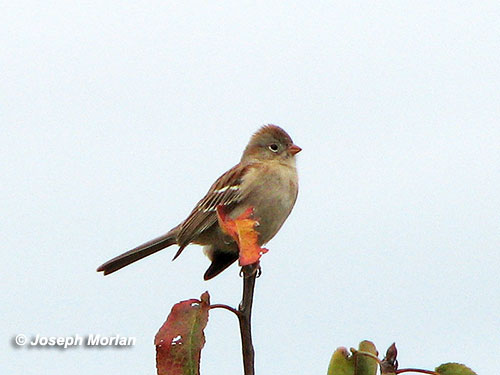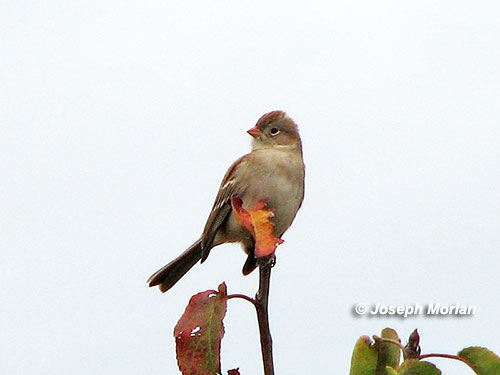Field Sparrow (Spizella pusilla)
Crocker-Amazon neighborhood, San Francisco, San Francisco County, CA
28 December 2012
Joseph Morlan
Photos © 28 December 2012 by Joseph Morlan. All rights reserved (Higher resolution images).
 After
learning that a Field Sparrow was visiting the yard of Kevin McKereghan in the Crocker-Amazon neighborhood of San
Francisco, Robbie Fischer and I arranged for a visit. We arrived about 1:45pm and the bird appeared about 15 minutes
later. It flew in to a Redbud with a small flock of White-crowned Sparrows and House Finches. The flock quickly
moved to the top of a small tree where the birds sat in the open for about five minutes before disappearing into
a neighboring yard. The birds did not visit the feeders during our brief visit. I attempted to take photos with
my Canon SI3 IS ultra-zoom with the results here. Several other birders took photos at this time. Kevin McKereghan
posted two images on the SFBirds
email group. Unfortunately this private yard is not visible from the street and Kevin is leaving for vacation.
After
learning that a Field Sparrow was visiting the yard of Kevin McKereghan in the Crocker-Amazon neighborhood of San
Francisco, Robbie Fischer and I arranged for a visit. We arrived about 1:45pm and the bird appeared about 15 minutes
later. It flew in to a Redbud with a small flock of White-crowned Sparrows and House Finches. The flock quickly
moved to the top of a small tree where the birds sat in the open for about five minutes before disappearing into
a neighboring yard. The birds did not visit the feeders during our brief visit. I attempted to take photos with
my Canon SI3 IS ultra-zoom with the results here. Several other birders took photos at this time. Kevin McKereghan
posted two images on the SFBirds
email group. Unfortunately this private yard is not visible from the street and Kevin is leaving for vacation.
Description
The following description is based on memory and on photos:
A small sparrow with a very long tail. The bird was decidedly smaller than nearby White-crowned Sparrows.
The bill was short and stubby, and fairly bright pink in color on both mandibles.
The crown was mostly rusty or rufous color, but the median area on the top of the head was gray, separating
the reddish area into two broad lateral crown stripes which connected across the forehead. The face was rather
plain gray with a faint rufous smudge extending behind the eye. The dark eye had a crisp well-defined white eyering.
The eyering seemed better defined in the field than it does in my photos.
The throat was whitish, contrasting with the grayish chest and was framed by two short lateral throat stripes
(whisker marks). The rest of the underparts were fairly pale gray with a strong rufous smudge on the sides of the
breast near the bend of the wing and some rusty-brown smudging across the middle of the chest. The upperparts were
gray-brown with fairly broad black streaks. The scapulars were suffused with rust. The wings showed two prominent
white wing-bars formed by the white tips to the greater and median coverts. The the greater wing coverts, secondaries
and tertials were otherwise black with brown fringes on the outer webs. The visible primary coverts were dark charcoal
and contrasted with the rest of the wing. The very long tail was gray-brown above and pale gray below. 
Discussion
Age and sex
Field Sparrows are difficult to age unless examined in the hand. However, the contrasting primary coverts clearly
visible in photos suggest this may be a young bird (hatching year HY). Females average slightly smaller than males
and are more dull in color. This bird is much brighter and appeared slightly larger than the individual studied
at Point Reyes last month suggesting this might be a male, but the sex of these birds is probably not determinable
with confidence.
Species
The identification is relatively straightforward. The most likely species to cause confusion is Brewer's Sparrow
(Spizella breweri). Brewer's often shows a fairly clear eyering and may show a pinkish bill. However, the
crown of Brewer's is brown with dusky streaks throughout, unlike the largely rufous cap of the Field Sparrow. Brewer's
also has more of an outline to the brown ear coverts, and is overall a colder brown-colored bird.
Another confusion species is Worthen's Sparrow (S. wortheni) which has dark legs and feet, lacks wing-bars
and has the rufous lateral crown stripes separated through the forehead instead of connected. Worthen's is locally
distributed in Northeast Mexico and has not been recorded in North America since the type specimen was reportedly
collected in Silver City, New Mexico in the 19th century.
Subspecies
Two races are currently recognized. The nominate S. p. pusilla is found in the East. It has a more distinct
gray median and back streaking. It also usually shows a brownish ear patch which contrasts with the gray of the
face and breast, and has a relatively shorter tail. Most California records have shown characters of the western
Great Plains race S. p. arenacea which has a plainer face, less contrasting median stripe and back streaking
and a relatively longer tail. However, without reference to specimens, I prefer to leave the subspecies question
open for now.
 After
learning that a Field Sparrow was visiting the yard of Kevin McKereghan in the Crocker-Amazon neighborhood of San
Francisco, Robbie Fischer and I arranged for a visit. We arrived about 1:45pm and the bird appeared about 15 minutes
later. It flew in to a Redbud with a small flock of White-crowned Sparrows and House Finches. The flock quickly
moved to the top of a small tree where the birds sat in the open for about five minutes before disappearing into
a neighboring yard. The birds did not visit the feeders during our brief visit. I attempted to take photos with
my Canon SI3 IS ultra-zoom with the results here. Several other birders took photos at this time. Kevin McKereghan
posted two images on the SFBirds
email group. Unfortunately this private yard is not visible from the street and Kevin is leaving for vacation.
After
learning that a Field Sparrow was visiting the yard of Kevin McKereghan in the Crocker-Amazon neighborhood of San
Francisco, Robbie Fischer and I arranged for a visit. We arrived about 1:45pm and the bird appeared about 15 minutes
later. It flew in to a Redbud with a small flock of White-crowned Sparrows and House Finches. The flock quickly
moved to the top of a small tree where the birds sat in the open for about five minutes before disappearing into
a neighboring yard. The birds did not visit the feeders during our brief visit. I attempted to take photos with
my Canon SI3 IS ultra-zoom with the results here. Several other birders took photos at this time. Kevin McKereghan
posted two images on the SFBirds
email group. Unfortunately this private yard is not visible from the street and Kevin is leaving for vacation.